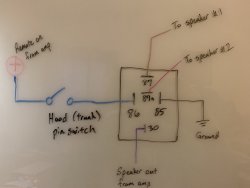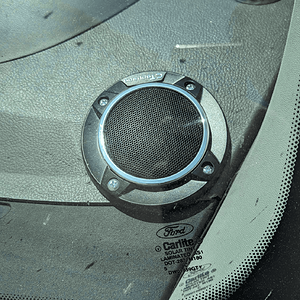Hey all!
Ok, so I've been out of the car audio and electronics game for just a bit.... I used to be an installer at Circuit City if that tells you how long it's been, but I do remember some fundamentals.
So here's my story:
I am building a small system for my 16 y/o son's '98 Altima. I plan to put a single 12" sub in a rear facing box with rear panel that will snug up against the back seat. I ended up with a couple extra pairs of speakers (don't ask...) and am thinking of mounting them on that back panel. The issue is I really only want them to be on when the trunk lid opens. I figure I can use an amp (audio source) and relays to reroute the audio from the internal speakers to the ones mounted in the trunk.
This is my idea:
Use a normal 5-pin relay to switch audio from an internal speaker (Speaker #1) to an external speaker (Speaker #2). The power source for the relay will be tied to a hood pin switch mounted in the trunk. Then I'd wash, rinse, and repeat for each speaker I want to switch. See attached image for a visual of the wiring setup.
My questions are:
1 - Do you think the above would work?
2 - If so, would I get noise through the audio by running the sound voltage through a relay?
3 - Is there anything like this already available on the market?
4 - Would there be any issues if I just switched (through the relay) the positive for each speaker while running the negative straight to the amp?
Thanks for the help!
Jon

Ok, so I've been out of the car audio and electronics game for just a bit.... I used to be an installer at Circuit City if that tells you how long it's been, but I do remember some fundamentals.
So here's my story:
I am building a small system for my 16 y/o son's '98 Altima. I plan to put a single 12" sub in a rear facing box with rear panel that will snug up against the back seat. I ended up with a couple extra pairs of speakers (don't ask...) and am thinking of mounting them on that back panel. The issue is I really only want them to be on when the trunk lid opens. I figure I can use an amp (audio source) and relays to reroute the audio from the internal speakers to the ones mounted in the trunk.
This is my idea:
Use a normal 5-pin relay to switch audio from an internal speaker (Speaker #1) to an external speaker (Speaker #2). The power source for the relay will be tied to a hood pin switch mounted in the trunk. Then I'd wash, rinse, and repeat for each speaker I want to switch. See attached image for a visual of the wiring setup.
My questions are:
1 - Do you think the above would work?
2 - If so, would I get noise through the audio by running the sound voltage through a relay?
3 - Is there anything like this already available on the market?
4 - Would there be any issues if I just switched (through the relay) the positive for each speaker while running the negative straight to the amp?
Thanks for the help!
Jon

Last edited by a moderator:


